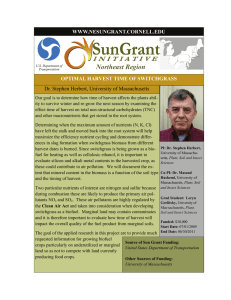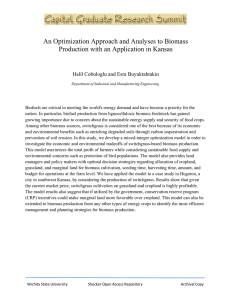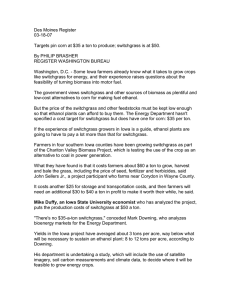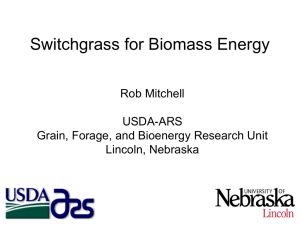Video 5 Learning Module
advertisement
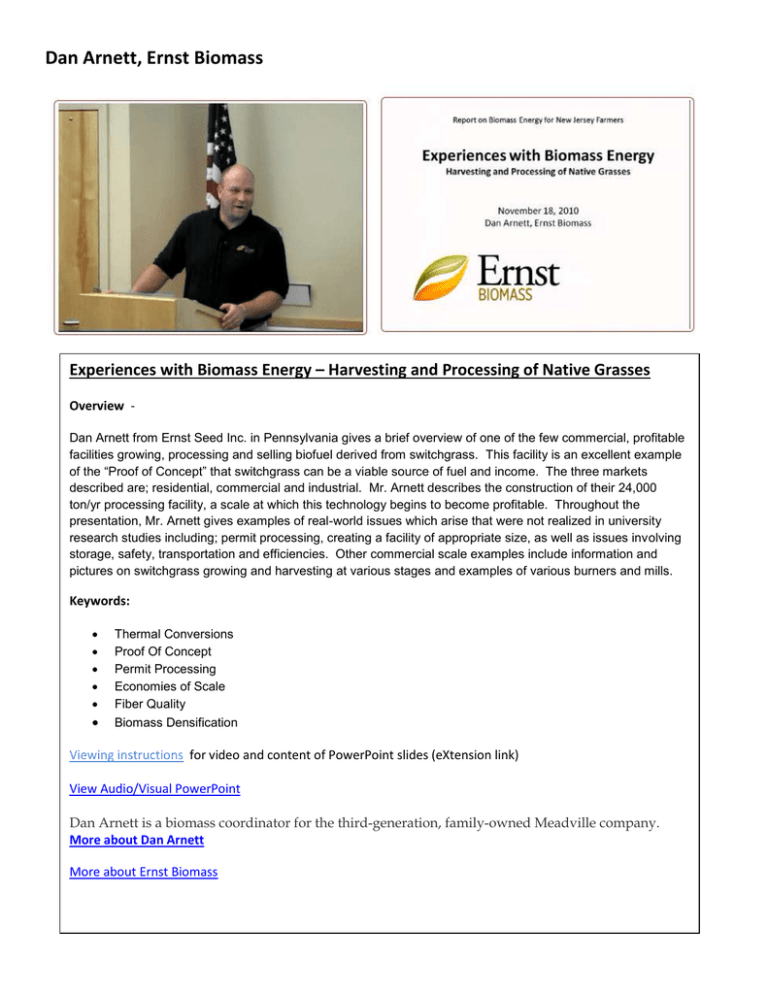
Dan Arnett, Ernst Biomass Experiences with Biomass Energy – Harvesting and Processing of Native Grasses Overview Dan Arnett from Ernst Seed Inc. in Pennsylvania gives a brief overview of one of the few commercial, profitable facilities growing, processing and selling biofuel derived from switchgrass. This facility is an excellent example of the “Proof of Concept” that switchgrass can be a viable source of fuel and income. The three markets described are; residential, commercial and industrial. Mr. Arnett describes the construction of their 24,000 ton/yr processing facility, a scale at which this technology begins to become profitable. Throughout the presentation, Mr. Arnett gives examples of real-world issues which arise that were not realized in university research studies including; permit processing, creating a facility of appropriate size, as well as issues involving storage, safety, transportation and efficiencies. Other commercial scale examples include information and pictures on switchgrass growing and harvesting at various stages and examples of various burners and mills. Keywords: Thermal Conversions Proof Of Concept Permit Processing Economies of Scale Fiber Quality Biomass Densification Viewing instructions for video and content of PowerPoint slides (eXtension link) View Audio/Visual PowerPoint Dan Arnett is a biomass coordinator for the third-generation, family-owned Meadville company. More about Dan Arnett More about Ernst Biomass Essays1. If you were assigned the duty of scouting for a location of a new biofuel growing and processing plant, what variables should you take into account and why? Include issues such as weather, distance to customers, etc. Many factors must be taken into account when scouting for a location of a biofuel growing and processing plant. For the growing aspects, the needs of switchgrass itself must be considered. Because switchgrass can be grown on “marginal land”, this can be bought/leased at a lower rate than more costly prime agricultural land, saving the farmer money. Since switchgrass is a native species, it can be grown in most climactic areas in the Northeast but some areas may be better suited to produce higher yields. For example, growing near the Great Lakes where Ernst Seeds, Inc. is located, tends to have a more “wet” weather system which may lead to difficulties when harvesting. As described in the video, some of the costly overhead issues involve storage and transportation. A facility should be located in an area which has appropriate acreage to build storage silo’s as the company expands and which has relatively liberal policies and constructing such storage facilities that will not require excessive permitting costs and bureaucracy. Transportation is the second overhead factor to keep in mind. Trucking the finished products in the form of pellets or briquettes can be very costly, especially if trucking out of state and in some cases may cost more than the product itself. This must be taken into account because it may not be cost effective for the customer to continue to purchase from the plant if the price of the product plus transportation is higher than more traditional sources of energy. 2. A small seed company growing and processing common vegetable seeds is struggling to remain in business due to high production costs and low market prices. How can the owners change their business model to increase profitability and why? Include changing the type of seed produced, seed applications, and customer base and why each would lead to increased profitability. The seed company described above may be more profitable if they alter their business model to grow seed for native plant species. Native plant species seeds can be sold for one of two applications. The first application can be for the production of biofuels such as switchgrass. The second application can be seed production for native plant species to be used for bioremediation projects such as wetland construction, wildlife habitats or erosion control. On the production side, growing native plant species has much lower costs than growing vegetable plants. This is due to the lower costs of inputs such as pesticides, herbicides, fertilizers, water, etc. as well as lower labor costs. Also, these species can be grown on less costly “marginal” land. On the marketing side, growing native plants for their seeds will give a higher price point than standard vegetable seeds because it is a niche market. The lack of competition from the large multinational seed corporations will enable the grower to dictate price to the customer. Also, the bioremediation industry is rapidly increasing as more strict State and Federal rules come into effect while the number of small vegetable growers is sharply decreasing, especially in the Northeast region. Multiple Choice1. Besides biofuels, switchgrass can be used for all applications except: a. Wetland Mitigation b. Wildlife Habitat c. Human Consumption d. Erosion Control 2. The best time to harvest switchgrass if seeking a low moisture content is: a. Spring b. Summer c. Fall d. Winter 3. When harvesting switchgrass, growers must be mindful of all except: a. Storage b. Safety c. Noise Control d. Transportation/Loading 4. The least expensive way to process switchgrass is a. Ground and Chopped b. Pelletize c. Briquettes d. Fermentation for Ethanol 5. Which is not a type of Biomass Densification? a. Cubing b. Baling c. Briquetting d. Pelletizing 6. Mechanical briquetting is superior to hydraulic briquetting in all aspects except: a. Higher Production Rates b. Better Product Quality c. Higher Efficiency d. Lower Costs True/False1. In the Northeast region, the retail and wholesale price of native plant seeds used for biofuels or environmental conservation has been increasing. False 2. The competition between private companies dedicated to the production of solid fuel from native warm season grasses is high due to the large number of companies spread throughout the Northeast. False 3. In terms of safety, straw in bale form is very unstable. True 4. Baled switchgrass is easier to handle than ground/chopped. True Fill in the Blank1. Three common markets for solid fuel are Residential, Commercial, and Industrial. 2. When scaling up a biofuel growing and processing plant to increase revenue, the planners must be sure there is not a decrease in Fiber Quality.
